+ データを開く
データを開く
- 基本情報
基本情報
| 登録情報 | データベース: PDB / ID: 7vdm | ||||||
|---|---|---|---|---|---|---|---|
| タイトル | Cryo-EM structure of pseudoallergen receptor MRGPRX2 complex with substance P | ||||||
 要素 要素 |
| ||||||
 キーワード キーワード | MEMBRANE PROTEIN / G Protein-Coupled Receptor | ||||||
| 機能・相同性 |  機能・相同性情報 機能・相同性情報substance P receptor binding / positive regulation of corticosterone secretion / mast cell secretagogue receptor activity / Tachykinin receptors bind tachykinins / insemination / positive regulation of synaptic transmission, cholinergic / detection of abiotic stimulus / mast cell activation / positive regulation of lymphocyte proliferation / tachykinin receptor signaling pathway ...substance P receptor binding / positive regulation of corticosterone secretion / mast cell secretagogue receptor activity / Tachykinin receptors bind tachykinins / insemination / positive regulation of synaptic transmission, cholinergic / detection of abiotic stimulus / mast cell activation / positive regulation of lymphocyte proliferation / tachykinin receptor signaling pathway / positive regulation of action potential / positive regulation of acute inflammatory response / sleep / positive regulation of ossification / neuropeptide binding / negative regulation of heart rate / response to pain / mast cell degranulation / positive regulation of cytokinesis / associative learning / positive regulation of epithelial cell migration / neuropeptide signaling pathway / long-term memory / neuronal dense core vesicle / adenylate cyclase inhibitor activity / positive regulation of protein localization to cell cortex / T cell migration / Adenylate cyclase inhibitory pathway / response to hormone / D2 dopamine receptor binding / response to prostaglandin E / positive regulation of stress fiber assembly / adenylate cyclase regulator activity / G protein-coupled serotonin receptor binding / adenylate cyclase-inhibiting serotonin receptor signaling pathway / sensory perception of pain / cellular response to forskolin / regulation of mitotic spindle organization / positive regulation of synaptic transmission, GABAergic / Regulation of insulin secretion / positive regulation of cholesterol biosynthetic process / negative regulation of insulin secretion / G protein-coupled receptor activity / G protein-coupled receptor binding / response to peptide hormone / adenylate cyclase-inhibiting G protein-coupled receptor signaling pathway / cellular response to nerve growth factor stimulus / adenylate cyclase-modulating G protein-coupled receptor signaling pathway / regulation of blood pressure / centriolar satellite / G-protein beta/gamma-subunit complex binding / Olfactory Signaling Pathway / Activation of the phototransduction cascade / G beta:gamma signalling through PLC beta / Presynaptic function of Kainate receptors / Thromboxane signalling through TP receptor / G protein-coupled acetylcholine receptor signaling pathway / G-protein activation / Activation of G protein gated Potassium channels / Inhibition of voltage gated Ca2+ channels via Gbeta/gamma subunits / Prostacyclin signalling through prostacyclin receptor / G beta:gamma signalling through CDC42 / Glucagon signaling in metabolic regulation / G beta:gamma signalling through BTK / Synthesis, secretion, and inactivation of Glucagon-like Peptide-1 (GLP-1) / ADP signalling through P2Y purinoceptor 12 / Sensory perception of sweet, bitter, and umami (glutamate) taste / photoreceptor disc membrane / Glucagon-type ligand receptors / Adrenaline,noradrenaline inhibits insulin secretion / Vasopressin regulates renal water homeostasis via Aquaporins / GDP binding / Glucagon-like Peptide-1 (GLP1) regulates insulin secretion / G alpha (z) signalling events / ADP signalling through P2Y purinoceptor 1 / cellular response to catecholamine stimulus / ADORA2B mediated anti-inflammatory cytokines production / G beta:gamma signalling through PI3Kgamma / Cooperation of PDCL (PhLP1) and TRiC/CCT in G-protein beta folding / adenylate cyclase-activating dopamine receptor signaling pathway / GPER1 signaling / Inactivation, recovery and regulation of the phototransduction cascade / cellular response to prostaglandin E stimulus / G-protein beta-subunit binding / heterotrimeric G-protein complex / cell-cell signaling / G alpha (12/13) signalling events / sensory perception of taste / extracellular vesicle / signaling receptor complex adaptor activity / Thrombin signalling through proteinase activated receptors (PARs) / retina development in camera-type eye / G protein activity / positive regulation of cytosolic calcium ion concentration / GTPase binding / Ca2+ pathway / midbody / fibroblast proliferation / High laminar flow shear stress activates signaling by PIEZO1 and PECAM1:CDH5:KDR in endothelial cells / cell cortex 類似検索 - 分子機能 | ||||||
| 生物種 |  Homo sapiens (ヒト) Homo sapiens (ヒト) | ||||||
| 手法 | 電子顕微鏡法 / 単粒子再構成法 / クライオ電子顕微鏡法 / 解像度: 2.98 Å | ||||||
 データ登録者 データ登録者 | Li, Y. / Yang, F. | ||||||
| 資金援助 |  中国, 1件 中国, 1件
| ||||||
 引用 引用 |  ジャーナル: Nature / 年: 2021 ジャーナル: Nature / 年: 2021タイトル: Structure, function and pharmacology of human itch receptor complexes. 著者: Fan Yang / Lulu Guo / Yu Li / Guopeng Wang / Jia Wang / Chao Zhang / Guo-Xing Fang / Xu Chen / Lei Liu / Xu Yan / Qun Liu / Changxiu Qu / Yunfei Xu / Peng Xiao / Zhongliang Zhu / Zijian Li / ...著者: Fan Yang / Lulu Guo / Yu Li / Guopeng Wang / Jia Wang / Chao Zhang / Guo-Xing Fang / Xu Chen / Lei Liu / Xu Yan / Qun Liu / Changxiu Qu / Yunfei Xu / Peng Xiao / Zhongliang Zhu / Zijian Li / Jiuyao Zhou / Xiao Yu / Ning Gao / Jin-Peng Sun /  要旨: In the clades of animals that diverged from the bony fish, a group of Mas-related G-protein-coupled receptors (MRGPRs) evolved that have an active role in itch and allergic signals. As an MRGPR, ...In the clades of animals that diverged from the bony fish, a group of Mas-related G-protein-coupled receptors (MRGPRs) evolved that have an active role in itch and allergic signals. As an MRGPR, MRGPRX2 is known to sense basic secretagogues (agents that promote secretion) and is involved in itch signals and eliciting pseudoallergic reactions. MRGPRX2 has been targeted by drug development efforts to prevent the side effects induced by certain drugs or to treat allergic diseases. Here we report a set of cryo-electron microscopy structures of the MRGPRX2-G trimer in complex with polycationic compound 48/80 or with inflammatory peptides. The structures of the MRGPRX2-G complex exhibited shallow, solvent-exposed ligand-binding pockets. We identified key common structural features of MRGPRX2 and describe a consensus motif for peptidic allergens. Beneath the ligand-binding pocket, the unusual kink formation at transmembrane domain 6 (TM6) and the replacement of the general toggle switch from Trp to Gly (superscript annotations as per Ballesteros-Weinstein nomenclature) suggest a distinct activation process. We characterized the interfaces of MRGPRX2 and the G trimer, and mapped the residues associated with key single-nucleotide polymorphisms on both the ligand and G-protein interfaces of MRGPRX2. Collectively, our results provide a structural basis for the sensing of cationic allergens by MRGPRX2, potentially facilitating the rational design of therapies to prevent unwanted pseudoallergic reactions. | ||||||
| 履歴 |
|
- 構造の表示
構造の表示
| ムービー |
 ムービービューア ムービービューア |
|---|---|
| 構造ビューア | 分子:  Molmil Molmil Jmol/JSmol Jmol/JSmol |
- ダウンロードとリンク
ダウンロードとリンク
- ダウンロード
ダウンロード
| PDBx/mmCIF形式 |  7vdm.cif.gz 7vdm.cif.gz | 208.8 KB | 表示 |  PDBx/mmCIF形式 PDBx/mmCIF形式 |
|---|---|---|---|---|
| PDB形式 |  pdb7vdm.ent.gz pdb7vdm.ent.gz | 159.9 KB | 表示 |  PDB形式 PDB形式 |
| PDBx/mmJSON形式 |  7vdm.json.gz 7vdm.json.gz | ツリー表示 |  PDBx/mmJSON形式 PDBx/mmJSON形式 | |
| その他 |  その他のダウンロード その他のダウンロード |
-検証レポート
| 文書・要旨 |  7vdm_validation.pdf.gz 7vdm_validation.pdf.gz | 863.5 KB | 表示 |  wwPDB検証レポート wwPDB検証レポート |
|---|---|---|---|---|
| 文書・詳細版 |  7vdm_full_validation.pdf.gz 7vdm_full_validation.pdf.gz | 871.8 KB | 表示 | |
| XML形式データ |  7vdm_validation.xml.gz 7vdm_validation.xml.gz | 33.2 KB | 表示 | |
| CIF形式データ |  7vdm_validation.cif.gz 7vdm_validation.cif.gz | 51.6 KB | 表示 | |
| アーカイブディレクトリ |  https://data.pdbj.org/pub/pdb/validation_reports/vd/7vdm https://data.pdbj.org/pub/pdb/validation_reports/vd/7vdm ftp://data.pdbj.org/pub/pdb/validation_reports/vd/7vdm ftp://data.pdbj.org/pub/pdb/validation_reports/vd/7vdm | HTTPS FTP |
-関連構造データ
| 関連構造データ |  31923MC  7vdhC  7vdlC  7vuyC  7vuzC  7vv0C  7vv3C  7vv4C  7vv5C  7vv6C M: このデータのモデリングに利用したマップデータ C: 同じ文献を引用 ( |
|---|---|
| 類似構造データ |
- リンク
リンク
- 集合体
集合体
| 登録構造単位 | 
|
|---|---|
| 1 |
|
- 要素
要素
-Guanine nucleotide-binding protein ... , 3種, 3分子 ABG
| #1: タンパク質 | 分子量: 40415.031 Da / 分子数: 1 / 由来タイプ: 組換発現 / 由来: (組換発現)  Homo sapiens (ヒト) / 遺伝子: GNAI1 Homo sapiens (ヒト) / 遺伝子: GNAI1発現宿主:  参照: UniProt: P63096 |
|---|---|
| #2: タンパク質 | 分子量: 39418.086 Da / 分子数: 1 / 由来タイプ: 組換発現 / 由来: (組換発現)  Homo sapiens (ヒト) / 遺伝子: GNB1 Homo sapiens (ヒト) / 遺伝子: GNB1発現宿主:  参照: UniProt: P62873 |
| #3: タンパク質 | 分子量: 6375.332 Da / 分子数: 1 / 由来タイプ: 組換発現 / 由来: (組換発現)  Homo sapiens (ヒト) / 遺伝子: GNG2 Homo sapiens (ヒト) / 遺伝子: GNG2発現宿主:  参照: UniProt: P59768 |
-抗体 / タンパク質 / タンパク質・ペプチド / 非ポリマー , 4種, 4分子 SRL

| #4: 抗体 | 分子量: 30363.043 Da / 分子数: 1 / 由来タイプ: 組換発現 / 由来: (組換発現)  Homo sapiens (ヒト) Homo sapiens (ヒト)発現宿主:  |
|---|---|
| #5: タンパク質 | 分子量: 37123.984 Da / 分子数: 1 / 由来タイプ: 組換発現 / 由来: (組換発現)  Homo sapiens (ヒト) / 遺伝子: MRGPRX2, MRGX2 Homo sapiens (ヒト) / 遺伝子: MRGPRX2, MRGX2発現宿主:  参照: UniProt: Q96LB1 |
| #6: タンパク質・ペプチド | 分子量: 1350.629 Da / 分子数: 1 / 由来タイプ: 組換発現 / 由来: (組換発現)  Homo sapiens (ヒト) / 遺伝子: TAC1, NKA, NKNA, TAC2 Homo sapiens (ヒト) / 遺伝子: TAC1, NKA, NKNA, TAC2発現宿主:  参照: UniProt: P20366 |
| #7: 化合物 | ChemComp-CLR / |
-詳細
| 研究の焦点であるリガンドがあるか | N |
|---|---|
| Has protein modification | Y |
-実験情報
-実験
| 実験 | 手法: 電子顕微鏡法 |
|---|---|
| EM実験 | 試料の集合状態: PARTICLE / 3次元再構成法: 単粒子再構成法 |
- 試料調製
試料調製
| 構成要素 | 名称: The pseudoallergen receptor MRGPRX2 complex with substance P タイプ: COMPLEX / Entity ID: #1-#6 / 由来: RECOMBINANT |
|---|---|
| 由来(天然) | 生物種:  Homo sapiens (ヒト) Homo sapiens (ヒト) |
| 由来(組換発現) | 生物種:  |
| 緩衝液 | pH: 7.5 |
| 試料 | 包埋: NO / シャドウイング: NO / 染色: NO / 凍結: YES |
| 急速凍結 | 凍結剤: ETHANE |
- 電子顕微鏡撮影
電子顕微鏡撮影
| 実験機器 |  モデル: Titan Krios / 画像提供: FEI Company |
|---|---|
| 顕微鏡 | モデル: FEI TITAN KRIOS |
| 電子銃 | 電子線源:  FIELD EMISSION GUN / 加速電圧: 300 kV / 照射モード: SPOT SCAN FIELD EMISSION GUN / 加速電圧: 300 kV / 照射モード: SPOT SCAN |
| 電子レンズ | モード: BRIGHT FIELD |
| 撮影 | 電子線照射量: 58 e/Å2 フィルム・検出器のモデル: GATAN K2 SUMMIT (4k x 4k) |
- 解析
解析
| CTF補正 | タイプ: PHASE FLIPPING AND AMPLITUDE CORRECTION |
|---|---|
| 3次元再構成 | 解像度: 2.98 Å / 解像度の算出法: FSC 0.143 CUT-OFF / 粒子像の数: 636987 / 対称性のタイプ: POINT |
 ムービー
ムービー コントローラー
コントローラー













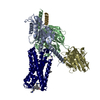
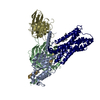

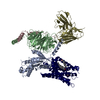
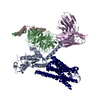



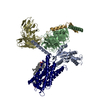
 PDBj
PDBj

































